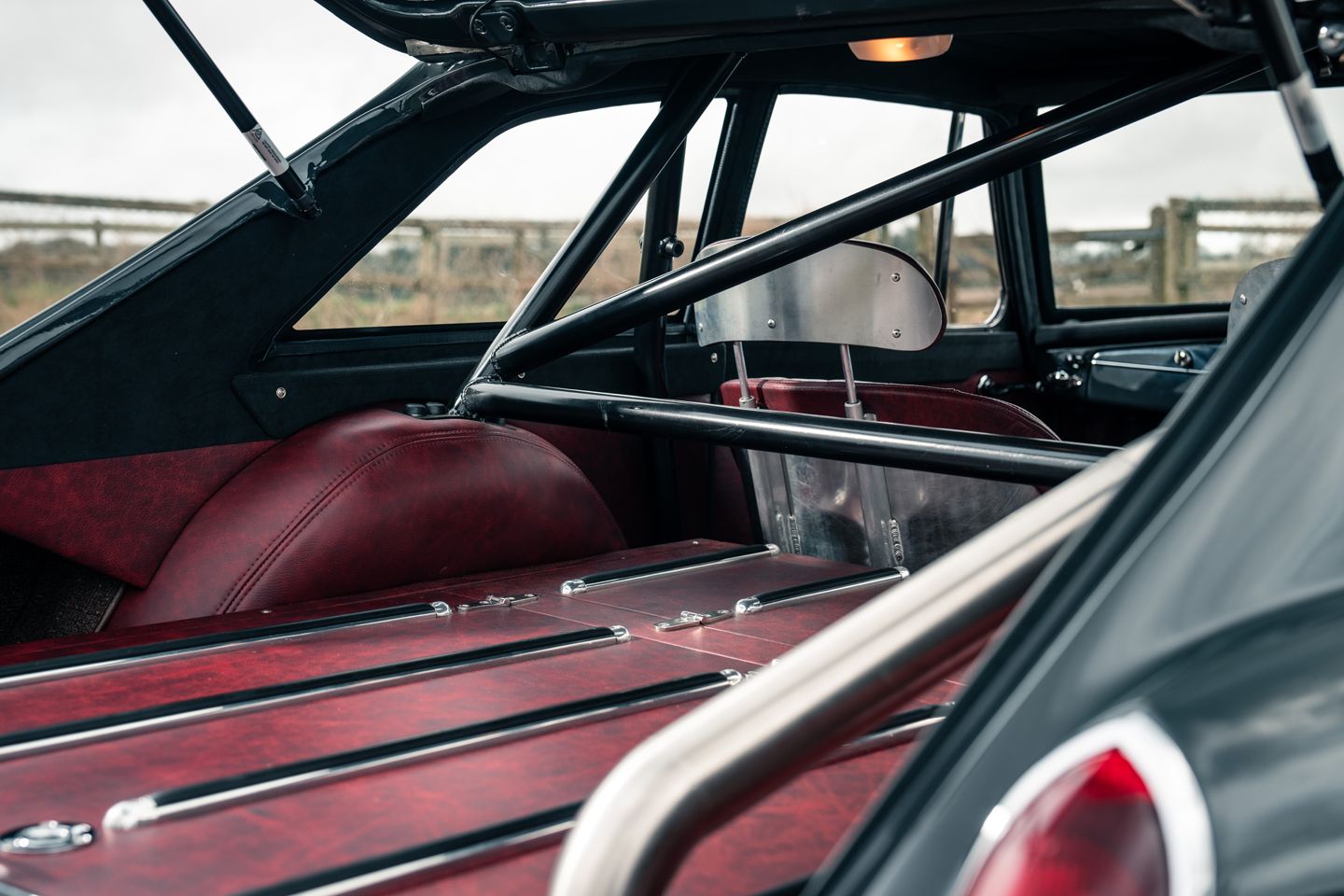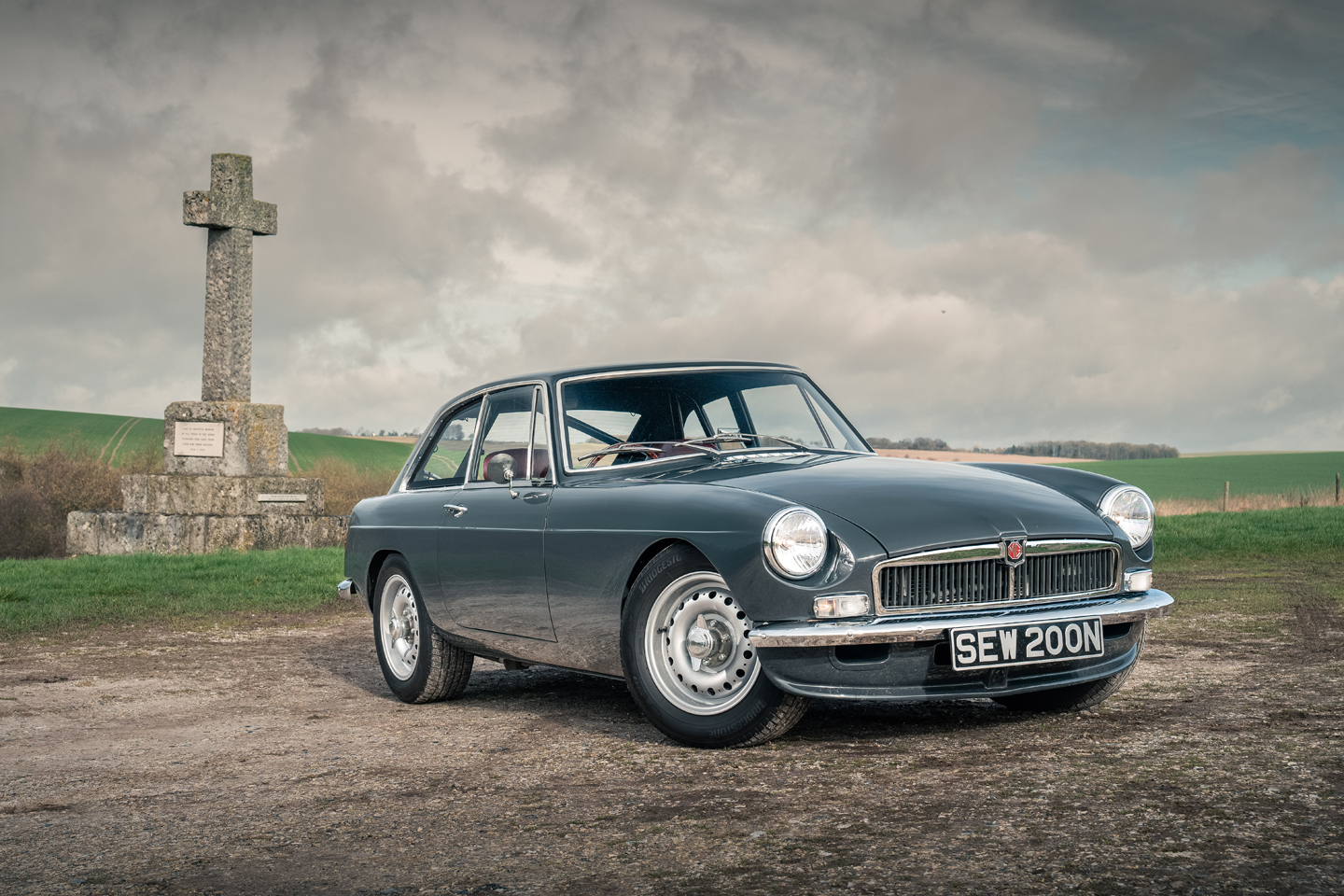
While a car should never be judged purely on the numbers, they can be a useful indicator. We’ve become worryingly familiar with podgy kerbweights, prodigious torque plateaus and middling revs on spec sheets, which makes the stats for Frontline’s 2.5-litre MG B a welcome return to the good old days, roughly the equivalent of watching Jaws on VHS. Even if the asking price is still rather more modern – but more on that in a sec.
This is far, far more than a 2.5-litre Duratec in a lovingly restored MG B. As standard, that engine struggles to muster 200hp, so for a Frontline installation it’s treated to a bespoke cam from Kent Cams, high compression pistons, forged rods, a ported head, new valves and springs, a lighter crank, a set of rorty, naughty Jenvey throttle bodies, Omex engine management and a stainless steel exhaust. Frontline says this is a 289hp, 240 lb-ft strong B, driving through a Mazda six-speed manual. Its 1,120kg kerbweight is split 52:48 front-to-rear, and it’ll reach 60mph in four seconds. The numbers don’t tell the whole story, yet it’s hard to imagine wanting much more on paper from a four-cylinder restomod. (Though there’s always the V8 for those who must have more power.)
Look at it, too – the wide-arched, broad-shouldered LE60 is a handsome hot rod, for sure, but the four-cylinder car really does highlight what a pretty shape the standard MG is. It’s small, narrow and dainty, a classic British sports car in the truest sense, although there are a few important details with this Frontline build that mark it out as something special – see the cage through the acres of glass, the stance on the Dunlop wheels, a pair of proper exhausts. It’s a beautiful old car, though it doesn’t take long to see that it’s not some delicate classic to be treated with kit gloves.


Numbers continue to be important inside the MG, too – look at the rev counter. It doesn’t start going amber until 7,000rpm, beyond where the V8 would call time. The red starts at 7,500rpm and Frontline says it’ll honk its merry little heart out to 7,800rpm. If your dream sports car weighs a little and revs a lot, there won’t be much better. The 2.5-litre drives, initially at least, as might be expected, with that healthy swept capacity ensuring a useful glug of torque when not trying too hard. The Mazda six-speed is as short and sweet as ever, and there’s a great deal of satisfaction from gurgling along with the window down.
But you gotta rev it. I mean really rev it. Frontline doesn’t have an exact rpm for peak power, but it must be beyond 7,000rpm, such is the way this 2.5 rips through the final throes. Those lightweight internals help exactly as intended, giving the engine such freedom and enthusiasm at higher speeds that it’s hard not to indulge the whole time. Perhaps if you were feeling picky a lighter flywheel would be the cherry on top to really ensure that last bit of zip, but it’s a reminder of how wonderful a well-sorted four-cylinder can be.
And the sound, of course, is divine: it’s that hard, loud, guttural induction growl that’s captivated so many over the decades in forests or grandstands. You don’t merely change gear for the sake of it, but find an excuse to blip the throttle again, or have someone else drive so those throttle bodies can be heard hungrily snorting at their best from outside.


So it looks good, sounds great and goes properly fast – all very encouraging. The Frontline drives smartly, too, though this isn’t in the same mould as the all-conquering LE60. Without those monster tracks, it doesn’t have quite the same unflappable composure, bite and stability; you need to think a bit more about entry speed as the purchase won’t be there, and understeer isn’t quite so easy to quell with a dab of throttle. No bother, though – it just means a change of approach. Make sure it’s slowed down, tip the nose towards the apex, then almost immediately get the throttle after. Just like the good old days, that helps steer the car around almost as much as the big wooden wheel. In fact, you soon learn to trust the six-link rear axle as much as the one ahead of you – Frontline has fitted electric power steering, and it still wants for some feedback. Hardly the end of the world, because a classic of any description will be sort of approximate to drive (or you’d just buy a new car), but a little more sensation wouldn’t go amiss.
Once adjusted to its quirks, however, there’s huge entertainment on offer because it feels so well sorted. It doesn’t flex or wobble, the Nitron dampers are plush, and the limited-slip diff drives the B out of bends with real conviction. You make allowances for this car because there’s not the outright grip, though you never make excuses – it really makes the absolute best of what you’re working with. And in 2024, something that feels genuinely small, requires some effort on your part (not least in the learning) and doesn’t cling on like a racing car is a welcome tonic.
Of course, that’s why the whole restomod genre has become so popular. But even allowing for the familiar old-made-new feeling, there’s something particularly captivating about the Frontline B. There’s always a huge amount of the classic car experience to savour, hemmed into a leather-lined cabin and always busy at the wheel, with what seems like an intelligently judged injection of modernity to the drive. At any commitment level, it’s a real pleasure to operate. This arguably feels a more faithful recreation of the MG B than the LE60, such is the V8’s ferocious power and ability. If you like the idea of a classic British sports car, if you like fizzy four-cylinders, and if you just like the engine in the front and power to the back, you’ll absolutely love this thing.


It’ll cost, mind, but then the day somebody can invest thousands of hours making an iconic coupe the best it can be and sell it for cheap the other restomods can all give up. This car is one of Frontline’s Bespoke builds, though its spec pays homage to Abingdon Edition, of which 50 were made a decade ago. So with the motor as it is, the diff, four-piston front brakes and so on, it’s £120k plus VAT. As it stands, however, this version is more like £135k, with the cage, better dampers, bigger brakes, air con, upgraded stereo and so on. Which might be hard to get over because seemingly nice MG Bs remain a tenth of that, although it wasn’t so long ago people were giving £20k 964s and hundreds of thousands to Singer; even starting cheap, doing a job well costs a lot.
This one lives its life as Frontline’s demo car, with eight thousand likely very persuasive miles under its wheels; it’d be very easy to drive and feel content without a rollicking V8, though you’d probably want to retain some of the surrounding extras that make the experience special. Beautiful to look at, a joy to drive and surely a pleasure to own (the residuals are strong, if that helps!) the Duratec-engined Frontline MG B might be all the sports car you’d ever need. In case the numbers hadn’t already convinced you.
SPECIFICATION | FRONTLINE MG B 2.5
Engine: 2.5-litre, four-cylinder
Transmission: 6-speed manual, rear-wheel drive
Power (hp): 289@N/Arpm
Torque (lb ft): 240@N/Arpm
0-62mph: 4.0 sec
Top speed: c. 150mph
Weight: 1,120kg
MPG: N/A
CO2: N/A
Price: from £120k plus VAT
Source link
#Frontline #Review



